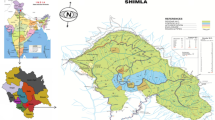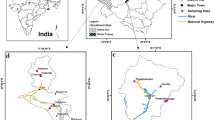Abstract
Riparian zone is an important component of forested watershed. Species component, structure, and distribution pattern of plant community in riparian zone are different from those of forest far away from the riparian zone because of edge effect and influence of river, and their minimum sampling areas are also different. To study the minimum area and α biodiversity of broad-leaved/Korean pine forest in riparian zone, three 8 m×32 m sampling belts were selected and distributed at elevation of 800 m, 900 m, and 1 000 m. In the riparian broad-leaved/Korean pine forest, mean minimum sampling areas including 60%, 80%, and 90% of total species were 80 m2 (8 m×10 m), 180 m2 (12 m×15 m), and 320 m2 (16 m×20 m) respectively; The corresponding mean minimum areas of non-riparian forest were about 260 m2, 380 m2, and 480 m2; and the former were smaller than the latter. In the riparian zone, species richness, Shannon-Weiner index and species evenness were also higher than those in non-riparian forest. On the contrary, species dominance in forest community was higher than that in riparian zone.
Similar content being viewed by others
References
Cai Qinghua, Wu G. and Liu Jiankang 1997. Watershed ecology: A new Method to study and conserve biodiversity of water ecosystem [J]. Science & Technology Review, (5): 24–26.
Cummins, K.W. 1974. Structure and function of stream ecosystems [J]. Bioscience,24: 631–641.
de Caprariis P, Lindemann, R.H. and Collins, C.M. 1976. A method for determining optimum sample size in species diversity studies [J]. Mathematical Geology,8(5): 575–581
Deng Hongbing, Hao Zhanqing, Jiang Ping,et al. 2000. Species frequency of communities along northern slope of Changbai Mountain, Northeast China [J]. Journal of Forestry Research,11(3): 187–190.
Deng Hongbing, Wang Qingchun, Wang Qingliu,et al. 2001a. On Riparian Forest Buffers and Riparian Management [J]. Chinese Journal of Applied Ecology,12(6): 951–954. (in Chinese)
Deng Hongbing, Hao Zhanqing and Wang Qingli. 2001b. The changes of co-possession of plant species between communities with altitudes on northern slope of Changbai Mountain [J]. Journal of Forestry Research,12(2): 89–92.
Deng Hongbing, Wang Qingli and Cai Qinghua. 1998. Watershed ecology: new discipline, new idea, and new approach [J]. Chinese Journal of Applied Ecology,9(4): 443–449.
Deng Hongbing, Wu Gang, Hao Zhanqing,et al. 1999. Determination of the minimum sampling area forPinus massoniana-quercus community and comparion of sampling methods [J]. Acta Ecologica Sinica,19(4): 499–503.
Gregory, S.V. 1997. Riparian management in the 21st century [C]. In: Kohm KA and Franklin JF (ed.) Creating a forestry for the 21st century: the science of ecosystem managemen. Washington DC: Island Press.
Hao Zhanqing. 2000. Analysis of plant community diversities and their gradient patterns on the north slope of Changbai Mountain [D]. Ph. D dissertation of Institute of Applied Ecology, Chinese Academy of Sciences. Shenyang: Institute of Applied Ecology, Chinese Academy of Sciences.
Jiang Mingxi and Cai Qinghua. 2000. Preliminary studies on the riparian plant communities of main channel in the Three Gorges area, the Yangtze river [J]. Acta Hydrobiologica Sinica,24(5): 458–463.
Liu Canran and Ma Keping. 1997. Measurement of biotic community diversity V. methods for estimating the number of species in a community [J]. Acta Ecologica Sinica,17(6): 15–23.
Liu Canran, Ma Keping, Yu Shunli,et al. 1998. Plant community diversity in Donglingshan Mountain, Beijing, China: The determination of critical sampling areas for several types of plant communities [J]. Acta Ecologica Sinica,18(1): 15–23.
Minshall, G.W., Cummins, K.W., Peterson, R.C.,et al. 1985. Development in stream ecology theory [J]. Canadian Journal of Fishery and Aquatic Sciences,42: 1045–1055.
Peng Shaolin. 1987. Ecological dominance of subtropical forest community in Guangdong province [J]. Acta Ecologica Sinica,7(1): 36–42.
Poole, R.W. 1974. An introduction to quantitative ecology [M]. New York: McGrawHill.
Vannote, R.L., Minshall, G.W., Cummins, K.W.,et al. 1980. The river continuum concept [J]. Can. J. Fishery and Aquatic Sci.,37: 130–137.
Wilkinson, L. 1990. SYSTAT: The System for Statistics [M]. Evanston, IL: SYSTAT, Inc.
Wang Bosun, Yu Shixiao, Peng Shaolin,et al. 1996. Experiment manual of plant sociology [M]. Guangzhou: Guangdong higher education press, 12–156.
Zheng Shizhang, Wu Qianhong, Wang Haibo, et al. 1994. General ecology—principle, methods and application [M]. Shanghai: Fudan University Press, 23–160.
Author information
Authors and Affiliations
Additional information
Foundation item: This paper was supported by the Chinese Academy of Sciences (A grant KZCX2-406), National Natural Science Foundation of China (NSFC39970123), and Changbai Mountain Open Research Station.
Biography: WANG Qing-chun (1970-), male, doctoral student in Institute of Applied Ecology, Chinese Academy of Sciences, Shenyang 110016 P. R. China.
Responsible editor: Zhu Hong
Rights and permissions
About this article
Cite this article
Qing-chun, W., Hong-bing, D., Qing-li, W. et al. Minimum sampling area and α biodiversity of riparian broad-leaved/Korean pine forest in Erdaobaihe forested watershed, Changbai Mountain. Journal of Forestry Research 13, 12–16 (2002). https://doi.org/10.1007/BF02857137
Received:
Issue Date:
DOI: https://doi.org/10.1007/BF02857137
Keywords
- Riparian zone
- Species-area curve
- Minimum sampling area
- α biodiversity
- Species richness
- Species evenness
- Broad-leaved/Korean pine forest
- Forested watershed




